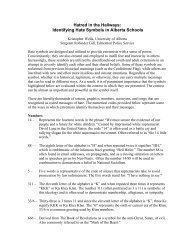ON ThE lEADiNG EDGELatest research in law enforcementThe following are excerpts from recentre-search related to justice <strong>and</strong> lawenforcement. To access the full reports,lease visit the website links at the bottom ofeach summary.Effect of drug-law enforcement ondrug-related violenceby the urban health Researchinitiative of thebritish Columbia Centre forExcellence in hiV/AiDSThe present systematic review evaluatedall available English-language publishedresearch on the impact of law enforcementon drug market violence. The hypothesiswas that the existing scientific evidencewould demonstrate an association betweendrug-law enforcement expenditures orintensity <strong>and</strong> reduced levels of violence.The initial search captured 306 studiesfor further analysis. Of these, 15 wereidentified that evaluated the impact of druglawenforcement on violence. Contrary toour primary hypothesis, 13 studies (87 percent) reported a likely adverse impact ofdrug-law enforcement on levels of violence.That is, most studies found that increasingdrug-law enforcement intensity resulted inincreased rates of drug market violence.The association between increaseddrug-law enforcement funding <strong>and</strong> drugmarket violence may seem counterintuitive.However, in many of the studies reviewedhere, experts delineated certain causativemechanisms that may explain thisassociation. Specifically, research hasshown that by removing key players fromthe lucrative illegal drug market, drug-lawenforcement may have the perverse effectof creating significant financial incentivesfor other individuals to fill this vacuum byentering the market.While theoretically it could be arguedthat some increase in drug-related violencecould be justified if drug-law enforcementreduced the flow of drugs, prior researchsuggests that law enforcement efforts havenot achieved their stated objectives withrespect to reducing drug supply <strong>and</strong> use.In fact, despite annual federal budgets ofapproximately US$15 billion <strong>and</strong> higherin the U.S. since the 1990s, illegal drugs— including heroin, cocaine <strong>and</strong> cannabis— have become cheaper, their purityhas increased, <strong>and</strong> rates of use have notmarkedly changed.In the face of strong evidence thatdrug-law enforcement has failed to achieveits stated objectives <strong>and</strong> instead appearsto contribute to drug market violence,policy makers must consider alternatives.In response to the known limitations oflaw enforcement in reducing drug supply,A U.S. study has found that many first responders have identified a need for more training in the area of hazardous materials.several medical <strong>and</strong> scientific bodies havecalled for the regulation of illicit drugs.The findings of this report do notimply that current government policies areresponsible for recent increases in violencein some cities, nor do they imply thatindividual police officers are responsiblefor this violence. Rather, the evidencesuggests that front-line police officers aregiven the task of enforcing drug laws thatappear to lead to increased violence byunintentionally driving up the enormousblack market profits attributable to theillegal drug trade.To accessthe full report, visit:uhri.cfenet.ubc.ca2009 National Training NeedsSurvey research brief: lawenforcementby the Rural DomesticPreparedness Consortium (u.S.)In 2005, the U.S. Congress established theRural Domestic Preparedness Consortium(RDPC) to develop <strong>and</strong> deliver all-hazardspreparedness training to rural communitiesacross America. In 2009, RDPC conductedits second National Training Needs Survey.The survey targeted a r<strong>and</strong>om sampleof individuals from eight disciplinesrepresentative of the rural emergencyresponse community.This brief focuses on the identifiedtraining needs of respondents across thelaw enforcement discipline. This sampleincluded officers from college/universitycampus departments, county policedepartments, sheriffs’ departments <strong>and</strong>municipal (city or town) police departments.Provided with a list of all 37 targetcapabilities (on the U.S. Department ofHomel<strong>and</strong> Security’s Target CapabilitiesList, which identifies <strong>and</strong> definescapabilities that communities may needto achieve <strong>and</strong> sustain in order to prevent,protect against, respond to <strong>and</strong> recover from32<strong>Gazette</strong> Vol. 72, No. 3, 2010
ON ThE lEADiNG EDGEmajor all-hazards events), respondents wereasked to indicate whether each capabilitywas important to their job function, aswell as whether they were confident inperforming the tasks associated with eachcapability. In comparing the results of thesetwo variables, training needs were revealed.The top five target capabilities thatrural law enforcement officers consideredmost important to their job functions, yetwere not confident in performing the tasksassociated with those functions, wereweapons of mass destruction (WMD) <strong>and</strong>hazardous materials (HAZMAT) response<strong>and</strong> decontamination (48.6 per cent);intelligence analysis <strong>and</strong> production (47.1per cent); chemical, biological, radiological,nuclear <strong>and</strong> explosive (CBRNE) detection(45.7 per cent); environmental health (45.7per cent); <strong>and</strong> isolation <strong>and</strong> quarantine (43.8per cent).One of the key findings among thelaw enforcement discipline was theoverwhelming indication of unmet trainingneeds in the area of WMD <strong>and</strong> CBRNEemergencies.Interestingly, this area was not citedby law enforcement officers as an unmettraining need in the original RDPC trainingneeds survey (RDPC, 2006), which maybe indicative of it having become a moreprominent training need within the last fewyears.As with the response to <strong>and</strong>decontamination of a WMD incidentor HAZMAT release discussed above,two additional (target) capabilities relateto the response to homel<strong>and</strong> securityrelatedevents. In fact, these capabilities(“environmental health” <strong>and</strong> “isolation<strong>and</strong> quarantine”) directly relate to a healthemergency or outbreak. Not only dothese two capabilities fall under the sameTCL (Target Capabilities List) missionarea as the capability discussed above,interestingly, they highlight the need for an“all-hazards” approach to training for lawenforcement officers.To accessthe full report, visit:www.ruraltraining.orgCrime risks of three-dimensionalvirtual environmentsby ian Warren <strong>and</strong> Darren Palmerfor the Australianinstitute of CriminologyThree-dimensional virtual environments(3dves) are the new generation of digitalmulti-user social networking platforms.Their immersive character [whichgenerates a three-dimensional imagethat appears to surround the user] allowsusers to create a digital humanizedrepresentation or avatar, enablinga degree of virtual interaction notpossible through conventional textbasedInternet technologies. As recentinternational experience demonstrates,in addition to the conventional range ofcybercrimes (including economic fraud,the dissemination of child pornography <strong>and</strong>copyright violations), the “virtual reality”promoted by 3dves is the source of greatspeculation <strong>and</strong> concern over a range ofspecific <strong>and</strong> emerging forms of crime <strong>and</strong>harm to users.This paper provides some examples ofthe types of harm currently emerging in3dves <strong>and</strong> suggests internal regulation byuser groups, terms of service or end-userlicensing agreements, possibly linked toreal-world criminological principles. Thispaper also provides some direction forfuture research aimed at underst<strong>and</strong>ingthe role of Australian criminal law <strong>and</strong>the justice system more broadly in thisemerging field.In a decentralized <strong>and</strong> highly technicalenvironment with high levels of user“responsibilization” [a process wherebysubjects are rendered individuallyresponsible for a task that previouslywould have been the duty of another]for harm identification, prevention <strong>and</strong>the development of appropriate normsof good conduct, there is considerableuncertainty surrounding the role of thecriminal law in these multi-user platforms.This uncertainty is compounded by thewide range of regulatory choices availableto users, confusion over the real-worldimplications of much of the behaviourwithin 3dves, the transnational appeal <strong>and</strong>jurisdictional uncertainties associated withthese emerging media, <strong>and</strong> the broader lackof empirical research documenting how3dve users perceive issues relating to harm,risk, safety <strong>and</strong> governance.The body of knowledge on each of theseissues is so recent that it is premature tospeculate on the ideal role of the criminallaw in this field. Nevertheless, a basictypology of harms associated with 3dve usecan help to clarify the various regulatory<strong>and</strong> harm-prevention strategies available toindividuals, user communities <strong>and</strong> formaljustice agencies.This paper outlines a graded series ofharms associated with 3dve use, rangingfrom behaviours with purely in-worldimplications considered too trivial to warrantformal action, to those with clearly actionableconsequences under the criminal law.Within these extremes, a grey area ofinter-real harms bridges the virtual <strong>and</strong>the real.Inter-real harms differ from conventionalcybercrimes due to the immersive characterof 3dve technologies. How 3dve users viewthe severity of these harms is the mostappropriate measure of the ideal regulatoryapproach in any given case. ▪To accessthe full report, visit:www.aic.gov.au<strong>Gazette</strong> Vol. 72, No. 3, 2010 33







